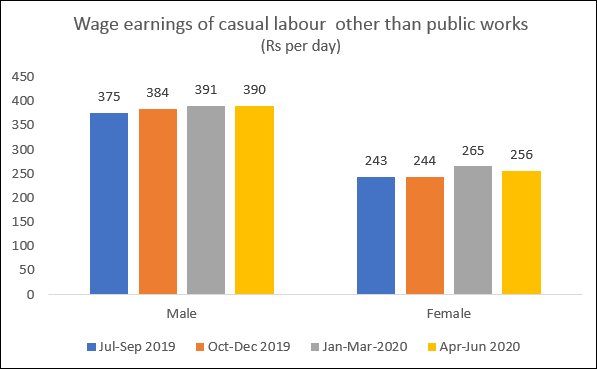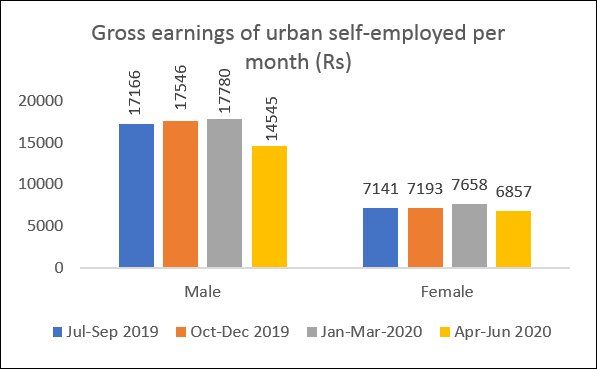Donald Trump’s tariffs have disrupted supply chains, roiled global markets, and escalated the trade war…
The Urgent Need for an Urban Employment Guarantee Scheme C. P. Chandrasekhar and Jayati Ghosh
At long last and more than a year after the need for such a scheme became obvious a parliamentary committee has recommended the institution of an urban employment scheme at the national level. The Standing Committee on Labour stated in its report of 3 August 2021 that “there is an imperative need for putting in place an Employment Guarantee Programme for the urban workforce in line with MGNREGA.” (Incidentally, the Committee also came down on the central government for failing to collect data on the number and conditions of migrant workers, who experienced such suffering during the first lockdown.)
The pressing need for an urban employment programme should have been obvious to the central government from the very start of the brutal and unplanned national lockdown from late March 2020, which stretched well beyond initial expectations and damaged or destroyed livelihoods especially of informal workers and the urban poor. But next to nothing was done, and the few paltry relief measures that have been provided over the past year have proved to be wholly inadequate to address the massive scale of employment and income loss.
Surveys conducted by private agencies like the CMIE had already indicated truly dramatic job losses in urban India over the past year, accounting for around 65 per cent of the estimated job losses of nearly 20 million jobs lost between Jan-Mar 2020 and Jan-Mar 2021. Now we also have evidence from the official surveys conducted by the National Sample Survey Organisation. The quarterly Periodic Labour Force Surveys were brought in specifically to provide “real time” evidence on the state of the labour market in India, but the results have been very delayed in coming in. Nevertheless, the latest report pertaining to July-September 2020 does provide evidence of the damage caused to employment and livelihood during the first wave of the Covid-19 pandemic and the first national lockdown. Despite some recovery after October 2020, the employment situation is likely to have deteriorated further after the second wave of early 2021.
Figure 1 presents the recognised work participation rate, or employment rate, over the quarters from July-Sep 2019 to July-Sep 2020. These rates are according to Current Weekly Status (which records the activity status on any average day over the previous week, including both principal and subsidiary activities), which is a better measure of actual demand in the labour market than the Usual Status. Both male and female employment rates in urban India, which in the immediate pre-pandemic period were already lower than historical rates, fell sharply in April-June 2020. Even in July-Sep 2020 they remained significantly below the pre-pandemic level, as much as 13 per cent lower for women.
But even this partial recovery in employment rates is misleading, because it was essentially due to a fairly big increase in the number of unpaid workers who helped in their family enterprises (like small shops and the like)—once again, dominantly among women workers (Figure 2). This is hardly a sign of labour market dynamism; more a reflection of the complete absence of other employment opportunities.
Figure 1: Urban employment rates fell during the lockdown
and remained below pre-pandemic rates

Source for Figures 1-3: NSSO Periodic Labour Force Survey Quarterly Report, July-September 2020.
Figure 2: Partial recovery in urban employment rates was mainly due to
increase in unpaid family workers, especially women

This is confirmed by the significant increase in open unemployment rates in urban areas, which have spiralled upwards well beyond the historical highs that were so widely discussed from in the 2017-18 labour force survey. Figure 3 shows that open unemployment in July-Sep 2020, post-lockdown, accounted for nearly 13 per cent of men and 16 per cent of women in the urban labour force. The conditions of young would-be workers was even worse: more than a quarter of young men and more than one-third of young women were openly unemployed at a time when the economy was supposedly recovering from the lockdown.
Figure 3: Open unemployment rates are especially high among the young

This dramatic deterioration of labour market conditions would inevitably affect workers’ earnings. We do not yet have data on wages for the period July-Sep 2020, but the annual PLFS report already provides a chilling description (Figure 4). Over April-June 2020, not only did employment go down, but so did the money wages of causal workers, which declined on average and particularly for women. In addition, the report also notes that the number of days worked declined substantially, which would further reduce the total wage earnings. Note that this entire period has been one of increasing prices of essentials, with food prices alone going up at an annual rate of around 6 per cent. So real wages would have declined even more. The earnings of self-employed declined even more, going down by 20 per cent for men and 10 per cent from women, from their already abysmally low levels.
Figure 4: Casual workers’ wages have declined even in money terms

Source for Figures 4-5: NSSO Periodic Labour Force Survey Annual Report 2019-20.
Figure 5: Self-employed earnings took a major hit

This is the depressing context within which it is now absolutely imperative to take urgent action to guarantee urban employment. The good news is that this is both feasible and affordable, and examples and templates for such a law and programme already exist.
Some state governments have attempted to bring in urban employment schemes on their own, but they are so cash-strapped—especially after the additional pandemic-related expenditures that were thrust on them by the insufficient spending by the Centre—that it has been all but impossible to do anything that would have a sufficient impact on the ground. Despite that, the efforts by the state governments of Kerala, Jharkhand, Himachal Pradesh, Odisha and Madhya Pradesh, suggest that there are initiatives that could be built upon and improved. In addition, some very viable templates for an urban employment programme have been developed by the Centre for Sustainable Employment at Azim Premji University. Now there are really no more excuses not to undertake this exercise on an immediate and urgent basis.
(This article was originally published in the Business Line on August 9, 2021)
